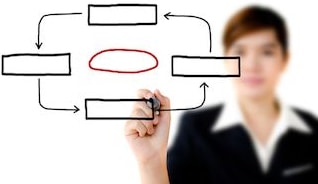MODA + MODE Knowledge as a Service
The MODA + MODE product line engineering knowledge repository is based on the four elements of W. Edwards Deming's System of Profound Knowledge framework:
The knowledge repository is a subscription service with the following features:
- Online access to a comprehensive product line management, design, and engineering knowledge base that reflects the experiences and needs from 50+ organisations who have used the service over the last decade
- Multi-dimensional perspectives, providing access to relevant guidance for specific situations and questions within one or two clicks, based on the concrete situations that our clients find themselves in
- Regularly updated with relevant material that takes into account new and emergent design paradigms and implementation options
- Direct access to product line management and engineering experts for interactive Q & A (phone and online)
In summary, the service offers comprehensive decision support for digital service and technology strategy development and evolution, with concrete benefits in terms of:
- Technology vendor independent validation based on experiences made by other organisations
- Risk minimisation
- Cost and quality management
Appreciation for a system
- Product Line
- A product line is a set of systems sharing a common, managed set of features that satisfy the needs of a particular market segment and that are developed from a common set of core assets in a prescribed way. Increasingly, with embedded software and digital services becoming an integral part of more and more product offerings, many of the systems in a product line are software-intensive systems or subsystems. Please refer to the introductory slides from the Product Line Practice of the Software Engineering Institute for more information.
- Kaizen Management System
- Kaizen utilizes a set of proven methods and tools to reduce waste and increase value for the client. These methods have been applied across the globe in every economic sector, and are known as the Kaizen Management System (KMS). The MODA + MODE methodology allows the deep domain knowledge that is uncovered by Kaizen to be formalised, and to be used in the context of process automation.
- Core Asset
- A core asset in a product line can be a technique or methodology building block, a formal model or language, a model execution engine or code generator, a software framework, a software component, or a hardware component or machine.
- Product Platform
- A product platform is the set of core assets in a product line, including all the tools needed for product engineering.
- Product Engineering
- Product engineering is the process of applying the results of domain engineering and automation to build concrete products from a common set of core assets.
Knowledge about variation
- Domain Analysis
- A systematic analytical technique for designing services and systems that are simple and easy to use. The input to this design process is the combination of market insights and all available insights into the variability of customer needs. S23M uses domain analysis to streamline and enhance how our clients interact with their customers and suppliers.
- Kaizen
- Literally means change for the better. The origins of Kaizen go back to the work of W. Edwards Deming in Japan to help rebuild Japanese industry following WWII. Kaizen is a process of lifelong learning and a never ending journey of quality improvements. It encompasses a tremendous amount of self-discipline and a commitment to
- everyday improvement,
- everybody improvement,
- everywhere improvement.
- Waigaya
- An embodiment of Soichiro Honda’s cultural style — which is best exemplified by his insistence that Honda employees favor unorthodoxy over imitation — waigaya comes in many forms. At the heart of waigaya is a single concept: paradoxes and disagreements are the essence of continuous improvement. Most companies are afraid of such dualities, but opposing concepts routinely alter the business equation: centralisation versus decentralisation, worker empowerment versus productivity, multinational control versus indigenous autonomy, disruptive innovation versus cannibalisation of existing product lines, and on and on. There are four basic rules for waigaya:
- Everybody is equal in waigaya;
- All ideas must be disputed until they are either proven valid or rejected;
- When a person shares an idea, he or she doesn't own it anymore — it belongs to the group and the group can do with it what it will;
- At the end of waigaya, decisions and responsibilities are generated — a precise list of who is to do what, and by when.
- Agile Software Development
- An approach that values
- individuals and interactions over processes and tools,
- working software over comprehensive documentation,
- customer collaboration over contract negotiation, and
- responding to change over following a plan.
Theory of knowledge
- Deming's System of Profound Knowledge
- W. Edwards Deming's theory and method, which shaped the Kaizen approach to continuous improvement,
is based on a system of profound knowledge that encompasses:
- Appreciation for a system – A system consists of a set of interacting parts, a boundary, and the context that lies beyond the boundary. Deming observes that a system generates emergent behaviour that cannot be predicted by analysing the behaviour of the parts, leading to a requirement to study the interactions of the parts in an experimental setting to gain deeper insight. Deming's observations provide a sound foundation for some of the key techniques in agile software development.
- Knowledge about variation – Understanding the causes of variation in the behaviour of a system is a prerequisite for making improvements. Deming’s theory makes use of statistical observations to uncover the causes of variation, an approach that complements the MODA approach for variability analysis and validation in the realm of software intensive systems.
- Theory of knowledge – Deming emphasises the critical role of domain-specific knowledge for improving a system. Product line engineering professionals have come to the same conclusion, which is reflected in the pivotal role of domain-specific modelling in the MODA + MODE methodology.
- Psychology – Observations on intrinsic motivation lead Deming to important conclusions about teamwork and productivity. The MODA approach builds on Deming’s observations, and also considers empirical results on cognitive bias and collaboration from modern behavioural economics.
- Domain Engineering
-
The discipline of creating and managing product lines. Domain engineering is a systematic process for employing highly organisation-specific expertise to determine the optimal scope for off-the-shelf solutions, to identify and create a common set of core assets, and to deliver an overall solution that does not compromise internal productivity. The resulting highly automated production facility must be maintained via Kaizen to minimise complexity and waste. S23M uses domain engineering to drive innovation and to streamline product engineering in your organisation.
- MODA + MODE Backbone
-
The following 26 principles provide a starting point (backbone) for the creation of learning organisations and understandable systems:
- Understand that minorities and outsiders are well positioned for uncovering attempts at deception
- Give minorities and outsiders access to private means of communication
- Operate transparent governance
- Adapt the cognitive load generated by technology to human cognitive limits
- Recognise neurological differences as authentic and valuable sources of innovative potential
- Value metrics from the physical and biological world more than human opinions
- Value local perspectives more than widely-held popular beliefs
- Value the strength of shared beliefs and corresponding evidence more than the number of shared beliefs
- Use information quality logic to minimise ambiguity
- Use probabilistic reasoning to acknowledge uncertainty
- Conduct commonality and variability analysis
- Formalise the results of commonality and variability analysis
- Develop visual domain specific languages to describe familiar domains in unambiguous terms
- Understand that all information is dependent on perspective and viewpoint
- Understand that a multitude of perspectives generates new insights
- Validate shared understanding by sharing of models and corresponding instances
- Understand that power gradients stand in the way of transformation
- Aim for optimal conflict in a supportive and trusting team environment
- Use agile experiments when venturing into unfamiliar domains to learn from mistakes
- Conduct an adequate number of experiments in different contexts to minimise risk before global application of major changes
- Understand that collaboration occurs to the extent that there is shared understanding
- Recognise paradoxes and disagreements as the essence of continuous improvement
- Practice everyday improvement, everybody improvement, everywhere improvement
- Engage in niche construction
- Use feedback loops to create learning systems
- Use modular decentralised design to promote reuse without compromising resilience
Psychology
- Neurodiversity
- A neologism with origins in the late 1990s that challenges the prevailing views of neurological diversity as inherently pathological, instead asserting that neurological differences should be recognised and respected as a social category on a par with gender, ethnicity, sexual orientation, or disability status. The neurodiversity movement frames autism, bipolar disorder and other neurotypes as a natural human variation rather than a pathology or disorder, and its advocates believe them to be authentic forms of human diversity and valuable sources of human talents and innovative potential.
- High Performance Team
- A group of people with specific roles and complementary talents and skills, aligned with and committed to a common purpose, who consistently show high levels of collaboration and innovation, that produce superior results. The high-performance team is regarded as tight-knit, focused on their goal and nothing else. Team members are so devoted to their purpose that they will surmount any barrier to achieve the team's goals. S23M creates a high performance team culture by applying the following guidelines for collaboration:
- Accept that a person's intent is good
- Value neurodiversity and support different working styles
- Believe in each others' capabilities
- Share personal context to improve communication
- Interpret questioning as a positive, not a challenge
- For the sender: Be open, direct, sincere, timely, motivating, and nonassumptive
- For the receiver: Assume good intentions of the sender, listen fully, ask clarifying questions (especially around tone), and maintain openness to learning
- Be self-aware. Know your strengths and weaknesses, and ask (verbally or in writing) how am I hindering communications.
- Optimal Conflict
-
Is a state of mind that improves learning in the context of waigaya. Optimal conflict is defined as:
- The persistent experience of some frustration, dilemma, life puzzle, quandary, or personal problem that is...
- perfectly designed to cause us to feel the limits of our current ways of knowing...
- in some sphere of our living that we care about, with...
- sufficient supports so that we are neither overwhelmed by the conflict nor able to escape or diffuse it.










